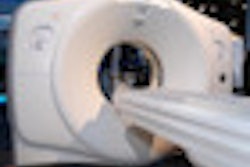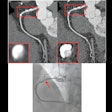Broader considerations for picking your scanner
In his talk, Robert Maliff looked beyond scanner features to focus on the business considerations of CT scanner selection. Among the most important issues is where the scanner will be sited, particular for larger institutions.
Oncology makes heavy use of CT for therapy planning, Maliff said, and a number of hospitals need a scanner in the radiation therapy department.
If the radiology department isn't located adjacent to the emergency department, it's always a challenge to move patients there for imaging, and many centers opt for a scanner in the department.
Emerging intraoperative CT applications require putting a scanner in the surgical suite, and critical care is another area where moving patients can be perilous. Some centers are using portable CT scanners, while others are installing full-sized models.
"A lot of the decisions in these extra care areas really come down to what the workflow is going to be, and how is radiology going to staff these departments with a CT-trained technician, and how that affects workflow," Maliff said. "Also, what's the utilization of a CT scanner expected to be? You certainly don't want to install a $1 million device where it's going to be used twice a day. There have to be some limits on how much we spend on technology, so let's look at the options in how we can better use resources in radiology or, if necessary, how can we best deploy to the outside area?"
With scanners being sited throughout the hospital, a radiation safety program will need to be in place. There is initial acceptance testing and annual quality assurance testing, as well as shielding concerns throughout the hospital. The hospital may have been designed to shield for a 16-detector-row scanner, he said, but have critical care areas been properly shielded for 128-detector-row models in critical care? Facility renovations will need to accommodate expanding deployment of CT scanners.
Utilization will need to be analyzed in each area, with estimated times for procedures, he said. Pediatrics and trauma can both throw off the most carefully planned schedule.
"You can't plan for traumas arriving at the emergency department on a routine basis," Maliff said. "Some hospitals pad the schedule so that every two hours they can move things around and get inpatients in. But once a trauma case comes in, your inpatient schedule goes out the door, with inpatients getting scanned at 9 or 10 at night. We don't want to inconvenience the outpatient schedule."
Beyond the scanner cost, it's important to budget for additional equipment, including contrast injectors, vital signs monitors, contrast warmers, storage cabinets, flow meters, regulators, phantoms, and sphygmomanometers, Maliff said.
Once you've bought the system, service plans are a big expenditure that needs to be well managed, he said. A lot of radiology managers prefer to get the point-of-sale service contract from the vendor, which is one option.
Multiyear point-of-service contracts come in many flavors, from basic to ultrapremium, he said, often sporting credit-card nomenclature like gold, silver, and platinum. Annual service costs for a 64-detector-row scanner range from about 6.3% to 9.5% of the scanner acquisition cost each year and must be included in any budget.
Looking at the bottom line
When choosing among different options, administrators need to look carefully at myriad factors that can affect the bottom line, including coverage periods, labor hour limits, travel mileage limits, and overage charges.
"If you have scheduled CT exams from 7 a.m. to 7 p.m., do you want a service contract that has p.m. service outside of the [contract] time?" Maliff asked. "You may think you have a full-service contract, but you find that all corrective maintenance is limited to a certain amount of hours per year. Do you really want to be in a position where there's a labor hour limit, and God forbid you have a lemon CT system?"
Other service options include CT vendor specialist training for in-house staff. Money can also be saved by having a trained specialist be the first point of contact for the vendor. Utilizing remote diagnostics can help keep the total cost in check by monitoring systems continually to try to foresee problems. It's critical to sign up for this option when the scanner is purchased and before signing a maintenance contract, Maliff said.
For the very brave (and large) facilities, self-insurance risk pools are another option.
"This is something that can be effective if set up well and funded well," he said. "It's not a methodology to get away from spending money; you have to allocate the money while you set up this risk pool every month. Otherwise, if there is a catastrophic failure and you don't have the money set aside -- wow, heads may roll."



















